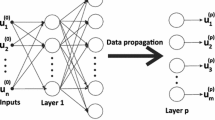Abstract
A brief analysis of the possibilities of using the method of artificial neural networks (ANNs) for assessing and correlating data on vapor–liquid equilibrium is presented. The advantages of the Focke method are considered in the case of a limited amount of data, in this case, the parameters of vapor–liquid equilibrium. Six binary and four ternary systems are considered using a modified Argatov–Kocherbitov technique. The estimation of the correctness of the ANN method is presented for the values of excess Gibbs energy calculated from the data on the vapor–liquid equilibrium.




Similar content being viewed by others
REFERENCES
Wilson, G., Vapor-liquid equilibrium. XI. A new expression for the excess free energy of mixing, J. Am. Chem. Soc., 1964, vol. 86, no. 2, pp. 127–130. https://doi.org/10.1021/ja01056a002
Renon, H. and Prausnitz, J.M., Local compositions in thermodynamic excess functions for liquid mixtures, AIChE J., 1968, vol. 14, no. 1, pp. 135–144. https://doi.org/10.1002/aic.690140124
Fredenslund, A., Jones, R.L., and Prausnitz, J.M., Group-contribution estimation of activity coefficients in nonideal liquid mixtures, AIChE J., 1975, vol. 21, no. 6, pp. 1086–1099. https://doi.org/10.1002/aic.690210607
Abrams, D.S. and Prausnitz, J.M., Statistical thermodynamics of liquid mixtures: A new expression for the excess Gibbs energy of partly or completely miscible systems, AIChE J., 1975, vol. 21, no. 1, pp. 116–128. https://doi.org/10.1002/aic.690210115
Gross, J. and Sadowski, G., Perturbed-chain SAFT: An equation of state based on a perturbation theory for chain molecules, Ind. Eng. Chem. Res., 2001, vol. 40, no. 4, pp. 1244–1260. https://doi.org/10.1021/ie0003887
Serafimov, L.A., State of the art in the thermodynamic and topological analysis of phase diagrams, Theor. Found. Chem. Eng., 2009, vol. 43, no. 3, pp. 268–278. https://doi.org/10.1134/S0040579509030051
Serafimov, L.A., Pisarenko, Yu.A., and Kulov, N.N., Coupling chemical reaction with distillation: Thermodynamic analysis and practical applications, Chem. Eng. Sci., 1999, vol. 54, no. 10, pp. 1383–1388. https://doi.org/10.1016/S0009-2509(99)00051-2
Serafimov, L.A. and Frolkova, A.K., Local regularities of phase diagrams of multiphase systems, Theor. Found. Chem. Eng., 1998, vol. 32, no. 4, p. 347.
Nguyen, V.D., Tan, R.R., Brondial, Y., and Fuchino, T., Prediction of vapor–liquid equilibrium data for ternary systems using artificial neural networks, Fluid Phase Equilib., 2007, vol. 254, nos. 1–2, pp. 188–197. https://doi.org/10.1016/j.fluid.2007.03.014
Moghadam, M. and Asgharzadeh, S., On the application of artificial neural network for modeling liquid-liquid equilibrium, J. Mol. Liq., 2016, vol. 220, pp. 339–345. https://doi.org/10.1016/j.molliq.2016.04.098
Roosta, A., Hekayati, J., and Javanmardi, J., Application of artificial neural networks and genetic programming in vapor–liquid equilibrium of C1 to C7 alkane binary mixtures, Neural Comput. Appl., 2019, vol. 31, p. 1165.
Farzaneh-Gord, M., Mohseni-Gharyehsafa, B., Ebrahimi-Moghadam, A., Jabari-Moghadam, A., Toikka, A., and Zvereva, I., Precise calculation of natural gas sound speed using neural networks: An application in flow meter calibration, Flow Meas. Instrum., 2018, vol. 64, p. 90.
Farzaneh-Gord, M., Rahbari, H.R., Mohseni-Gharyehsafa, B., Toikka, A., and Zvereva, I., Machine learning methods for precise calculation of temperature drop during a throttling process, J. Therm. Anal. Calorim., 2020, vol. 140, no. 6, p. 2765.
Haykin, S., Neural Networks: A Comprehensive Foundation, Englewood Cliffs, N.J.: Prentice-Hall, 1999.
Argatov, I. and Kocherbitov, V., A note on artificial neural network modeling of vapor-liquid equilibrium in multicomponent mixtures, Fluid Phase Equilib., 2019, vol. 502, article no. 112282. https://doi.org/10.1016/j.fluid.2019.112282
Focke, W.W., Mixture models based on neural network averaging, Neural Comput., 2006, vol. 18, no. 1, pp. 1–9. https://doi.org/10.1162/089976606774841576
Kudryavtseva, L.S. and Susarev, M.P., The vapor–liquid equilibrium in the chloroform–hexane and acetone–chloroform systems, Zh. Prikl. Khim., 1963, vol. 36, no. 6, p. 1231.
Vinichenko, I.G and Susarev, M.P., Study and calculation of the vapor–liquid equilibrium in the acetone–ethanol–n-hexane system, Zh. Prikl. Khim., 1966, vol. 39, p. 1583.
Kudryavtseva, L.S. and Susarev, M.P., The vapor–liquid equilibrium in the acetone–hexane and hexane– ethanol systems at temperatures of 35, 45, and 55°C and a pressure of 760 mm Hg, Zh. Prikl. Khim., 1963, vol. 36, no. 7, p. 1471.
Scatchard, G. and Raymond, C.L., Vapor–liquid equilibrium. II. Chloroform–ethanol mixtures at 35, 45 and 55°, J. Am. Chem. Soc., 1938, vol. 60, p. 1278.
Frolkova, A.V., Frolkova, A.K., and Chelyuskina, T.V., Separation of the acetone–chloroform–ethanol–water four-component system by autoextractive heteroazeotropic distillation, Vestn. MITKHT, 2010, vol. 5, no. 6, p. 27.
Kudryavtseva, L.S. and Susarev, M.P., The vapor–liquid equilibrium in the ethanol–chloroform–hexane system at temperatures of 35, 45, and 55°C and a pressure of 760 mm Hg, Zh. Prikl. Khim., 1963, vol. 36, no. 9, p. 2025.
Kudryavtseva, L.S. and Susarev, M.P., The vapor–liquid equilibrium in the acetone–chloroform–hexane system at temperatures of 35, 45, and 55°C and a pressure of 760 mm Hg, Zh. Prikl. Khim., 1963, vol. 36, no. 8, p. 1710.
Vinichenko, I.G., Study and calculation of the vapor–liquid equilibrium in the ethanol–chloroform–acetone– hexane four-component system, Cand. Sci. (Chem.) Dissertation, Leningrad: Leningrad State Univ., 1966.
ACKNOWLEDGMENTS
The authors are grateful to V. Kocherbitov (University of Malmö, Sweden) for useful advice. The research was carried out using the computing resources of the Resource Center “Computer Center of SPbU”.
Funding
The study was financially supported by the Russian Foundation for Basic Research (project no. 19-03-00375).
Author information
Authors and Affiliations
Corresponding author
Rights and permissions
About this article
Cite this article
Toikka, A.M., Misikov, G.K. & Petrov, A.V. Analysis of Data on Vapor–Liquid Equilibrium in Multicomponent Systems Using Artificial Neural Networks. Theor Found Chem Eng 55, 403–409 (2021). https://doi.org/10.1134/S004057952103026X
Received:
Revised:
Accepted:
Published:
Issue Date:
DOI: https://doi.org/10.1134/S004057952103026X




